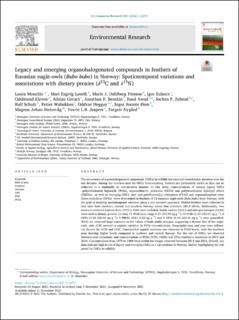| dc.contributor.author | Monclús, Laura | |
| dc.contributor.author | Løseth, Mari Engvig | |
| dc.contributor.author | Dahlberg Persson, Marie Johanne | |
| dc.contributor.author | Eulaers, Igor | |
| dc.contributor.author | Kleven, Oddmund | |
| dc.contributor.author | Covaci, Adrian | |
| dc.contributor.author | Benskin, Jonathan P. | |
| dc.contributor.author | Awad, Raed | |
| dc.contributor.author | Zubrod, Jochen P. | |
| dc.contributor.author | Schulz, Ralf | |
| dc.contributor.author | Wabakken, Petter | |
| dc.contributor.author | Heggøy, Oddvar | |
| dc.contributor.author | Øien, Ingar Jostein | |
| dc.contributor.author | Steinsvåg, Magnus Johan | |
| dc.contributor.author | Jaspers, Veerle | |
| dc.contributor.author | Nygård, Torgeir | |
| dc.date.accessioned | 2022-02-13T12:50:44Z | |
| dc.date.available | 2022-02-13T12:50:44Z | |
| dc.date.created | 2021-11-22T14:25:53Z | |
| dc.date.issued | 2021 | |
| dc.identifier.citation | Environmental Research. 2021, 204 . | |
| dc.identifier.issn | 0013-9351 | |
| dc.identifier.uri | https://hdl.handle.net/11250/2978574 | |
| dc.description.abstract | The occurrence of organohalogenated compounds (OHCs) in wildlife has received considerable attention over the last decades. Among the matrices used for OHCs biomonitoring, feathers are particularly useful as they can be collected in a minimally or non-invasive manner. In this study, concentrations of various legacy OHCs –polychlorinated biphenyls (PCBs), organochlorine pesticides (OCPs) and polybrominated diphenyl ethers (PBDEs)–, as well as emerging OHCs –per- and polyfluoroalkyl substances (PFAS) and organophosphate ester flame retardants (OPEs)– were determined in feathers of 72 Eurasian eagle-owls (Bubo bubo) from Norway, with the goal of studying spatiotemporal variation using a non-invasive approach. Molted feathers were collected at nest sites from northern, central and southern Norway across four summers (2013–2016). Additionally, two museum-archived feathers from 1979 to 1989 were included. Stable carbon (δ13C) and nitrogen isotopes (δ15N) were used as dietary proxies. In total, 11 PFAS (sum range 8.25–215.90 ng g− 1), 15 PCBs (4.19–430.01 ng g− 1), 6 OCPs (1.48–220.94 ng g− 1), 5 PBDEs (0.21–5.32 ng g− 1) and 3 OPEs (4.49–222.21 ng g− 1) were quantified. While we observed large variation in the values of both stable isotopes, suggesting a diverse diet of the eagle owls, only δ13C seemed to explain variation in PFAS concentrations. Geographic area and year were influential factors for δ15N and δ13C. Considerable spatial variation was observed in PFAS levels, with the southern area showing higher levels compared to northern and central Norway. For the rest of OHCs, we observed between-year variations; sum concentrations of PCBs, OCPs, PBDEs and OPEs reached a maximum in 2015 and 2016. Concentrations from 1979 to 1989 were within the ranges observed between 2013 and 2016. Overall, our data indicate high levels of legacy and emerging OHCs in a top predator in Norway, further highlighting the risk posed by OHCs to wildlife. Keywords: Bird of prey Feathers Isotopes OPE POP PFAS | |
| dc.language.iso | eng | |
| dc.title | Legacy and emerging organohalogenated compounds in feathers of Eurasian eagle-owls (Bubo bubo) in Norway: Spatiotemporal variations and associations with dietary proxies (δ13C and δ15N) | |
| dc.type | Peer reviewed | |
| dc.type | Journal article | |
| dc.description.version | publishedVersion | |
| dc.subject.nsi | VDP::Zoologiske og botaniske fag: 480 | |
| dc.subject.nsi | VDP::Zoology and botany: 480 | |
| dc.source.pagenumber | 9 | |
| dc.source.volume | 204 | |
| dc.source.journal | Environmental Research | |
| dc.identifier.doi | 10.1016/j.envres.2021.112372 | |
| dc.identifier.cristin | 1957353 | |
| dc.relation.project | Andre: County governor of Nordland | |
| dc.relation.project | Andre: County Governor of Trøndelag | |
| cristin.ispublished | true | |
| cristin.fulltext | original | |
| cristin.qualitycode | 2 | |
